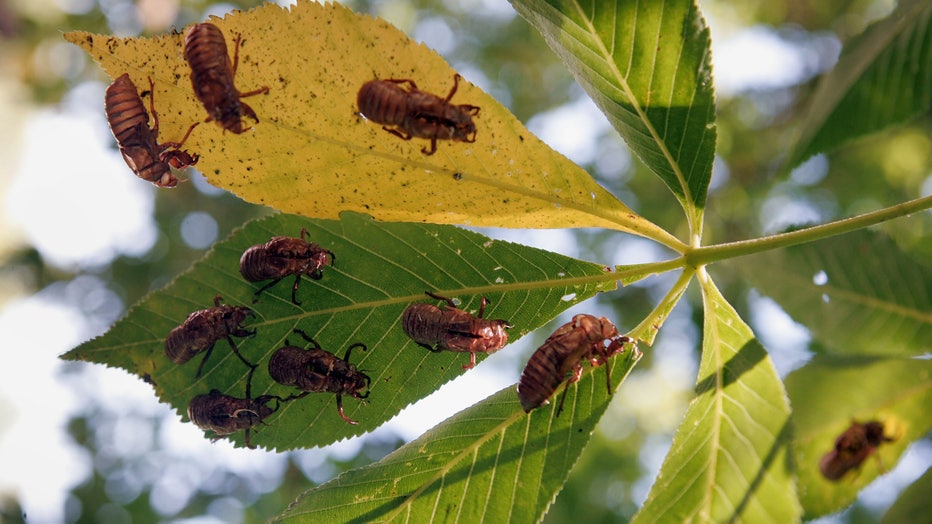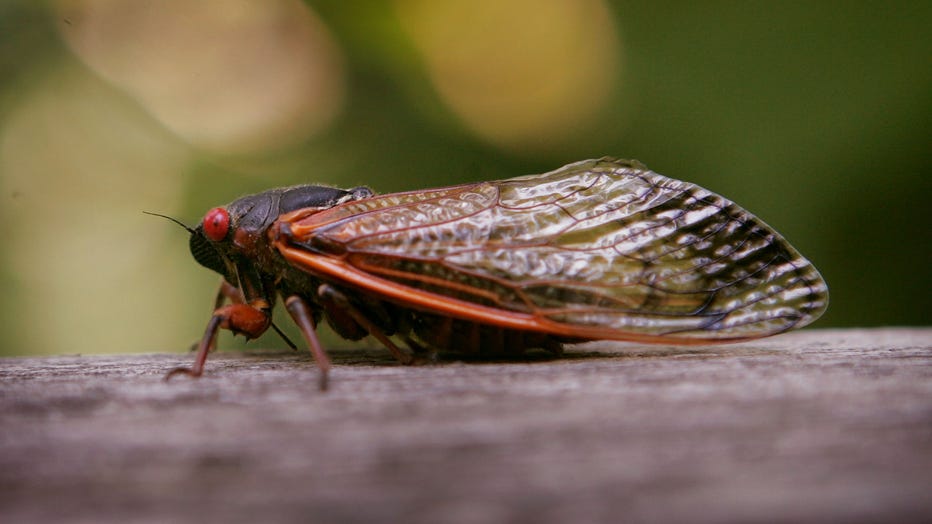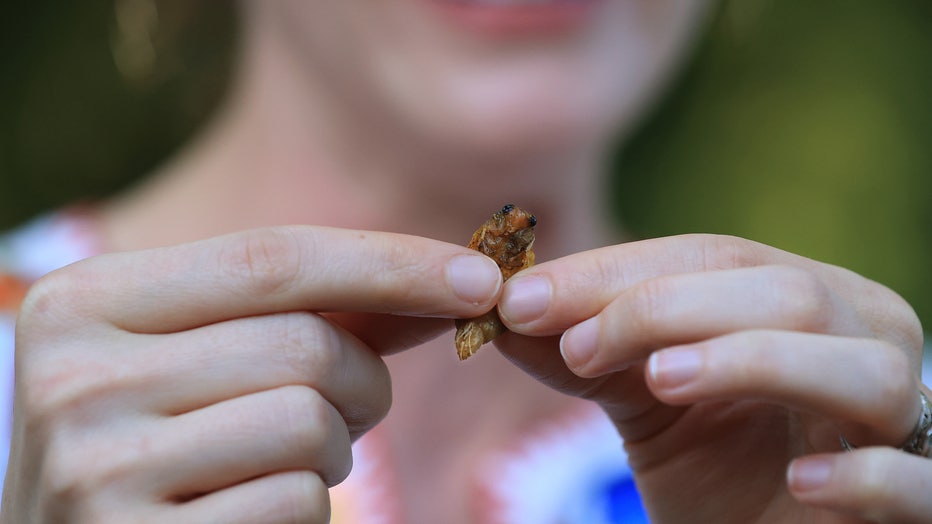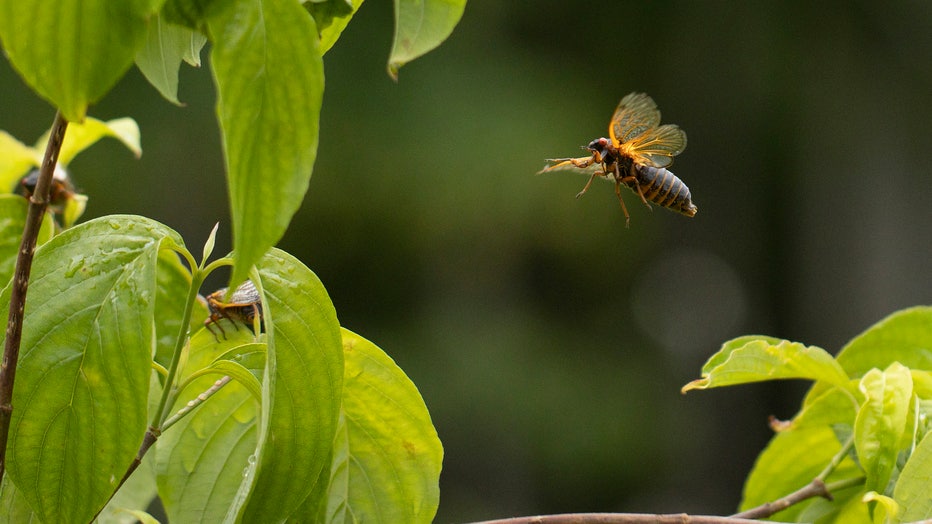2024 is the year of the double cicada emergence, a 'simultaneous explosion of bugs'

The Cicada insect re-emerges in Western Springs, IL on May 29, 2007. Two broods of periodical cicadas are emerging in 2024. (Photo by Stephen Azzato/NBCU Photo Bank/NBCUniversal via Getty Images via Getty Images)
It’s the year of the dragon for observers of Lunar New Year, but in North America, 2024 is the year of the cicada.
For the first time in 221 years, two broods of cicadas (not locusts) that spend the vast majority of their lives underground will emerge, invading backyards in 17 states. According to Cicada Mania, a website dedicated to cicadas, Illinois and Indiana are lucky enough to see both broods this year.
Most cicada species come out every year, but in the United States, there are two periodical broods of cicadas that stay underground for either 13 years or 17 years. The last time they came above ground at the same time was in 1803, "when Thomas Jefferson was president, and Napoleon was thinking about invading England," Hannah Fry, a British mathematician and science presenter, noted on her Instagram page.

Empty, nymphal skin of cicadas remain in a tree following the hatch of Brood XIII June 11, 2007 in Willow Springs, Illinois. Two broods of cicadas are simultaneously emerging in North America in 2024. (Photo by Scott Olson/Getty Images)
"If for 2024 you had the simultaneous explosion of green teenage bugs all across North America on your bingo card, you are in for a treat," Fry joked.
What are cicadas?
Cicadas are a family of insects called magicicadas, according to The Associated Press. They differ from other insects in that both the nymphs and adults have a beak they use to drink plant fluids. Adults have two sets of wings.
RELATED: Crickets flood Idaho road as the insects descend on neighboring Nevada
Cicadas are not locusts. They are not grasshoppers. Those are different species. But when Europeans first arrived in America, some started calling them locusts and even grasshoppers.
There are more than 190 known varieties of cicadas in North America and 3,390 of them around the world. Except for one species in India and one in Fiji, only the U.S. has the periodic cicadas that stay underground for most of their lives.

A cicada sits on a leaf at a forest preserve June 11, 2007 in Willow Springs, Illinois. Two broods of periodical cicadas are emerging in North America in 2024. (Photo by Scott Olson/Getty Images)
Cicadas don’t harm people or pets, though dogs have been known to binge and eat too many.
Scientists say you shouldn’t kill cicadas.
The only things cicadas can harm are young trees if they climb up them and try to plant eggs on weak young limbs. Experts say netting young trees protects them. Do not use pesticides.
What happens when cicadas emerge in North America?
When the periodical cicadas emerge from underground every 13 or 17 years, they do so simultaneously, "completely synchronized with one another," Fry explained.
RELATED: ‘The Last of Us’ zombie fungal parasite is real and causes ants to commit suicide
Once the males mate above ground, they die. After females lay their eggs – usually in small slits they carve into tree branches – they die.

A cicada sits on a fence at a forest preserve June 11, 2007 in Willow Springs, Illinois. Two broods of periodical cicadas are emerging in North America in 2024. (Photo by Scott Olson/Getty Images)
"So every single 13-year-old cicada emerges from the ground simultaneously, flies around, has a massive party, sheds their exoskeletons, makes a massive mess, then dies," Fry said. "They do this because it helps to evade predators. There’s so many of them simultaneously that there’s no way a predator could eat all of them … a massive proportion of them survive to the next generation."
A female can lay 400 to 600 eggs in a lifetime. The eggs hatch in late July to early August. Then the cicadas fall to the ground and immediately burrow underground. When cicadas die, they fertilize the trees and may smell a bit.
Where will cicadas emerge in 2024?
The two broods that will emerge simultaneously this year are Brood XIX (the 13-year cicadas) and Brood XIII (the 17-year cicadas).
Brood XIX, according to Cicada Mania, is expected to emerge in the spring of 2024 in Alabama, Arkansas, Georgia, Illinois, Indiana, Kentucky, Louisiana, Missouri, Mississippi, North Carolina, Oklahoma, South Carolina, Tennessee, and Virginia. The last time Brood XIX came above ground was in 2011.

Rose Agger takes a closer look at a pan-fried periodical cicada before eating it (Photo by Chip Somodevilla/Getty Images)
Brood XIII is expected to emerge in the spring of 2024 in Iowa, Wisconsin, Illinois, Indiana, and possibly Michigan. Cicada Mania says the last time this brood emerged was in 2007, though the AP reports they emerged in 2021.
When will cicadas emerge in 2024?
Both broods typically start to emerge in mid-May when the soil gets warm enough, and stay through late June, Cicada Mania says.
"A nice, warm rain will often trigger an emergence," the website says.

A periodical cicada, a member of Brood X, takes flight in the tree tops on June 03, 2021 in Columbia, Maryland. (Photo by Chip Somodevilla/Getty Images)
When they come out in mass numbers, they can be hard to avoid. They can seem to ruin weddings and large events just because there are so many of them.
Why are cicadas so loud?
Cicadas are known for their loud voices. According to the AP, it’s all about sex.
They sing by flexing small drum-like organs in their abdomens, and what you hear in the trees is called a chorus of males trying to attract females. Think of them as the insect version of a boy band. Each species has their own song. When the females are interested, they twitch their wings.

A drop of water lands on the back of a periodical cicada, a member of Brood X, on June 03, 2021 in Columbia, Maryland. (Photo by Chip Somodevilla/Getty Images)
Get thousands of them together and they can reach 105 decibels, which is louder than a lawnmower.
You can track and report cicada sightings on cicadasafari.org.
The Associated Press contributed to this report.

